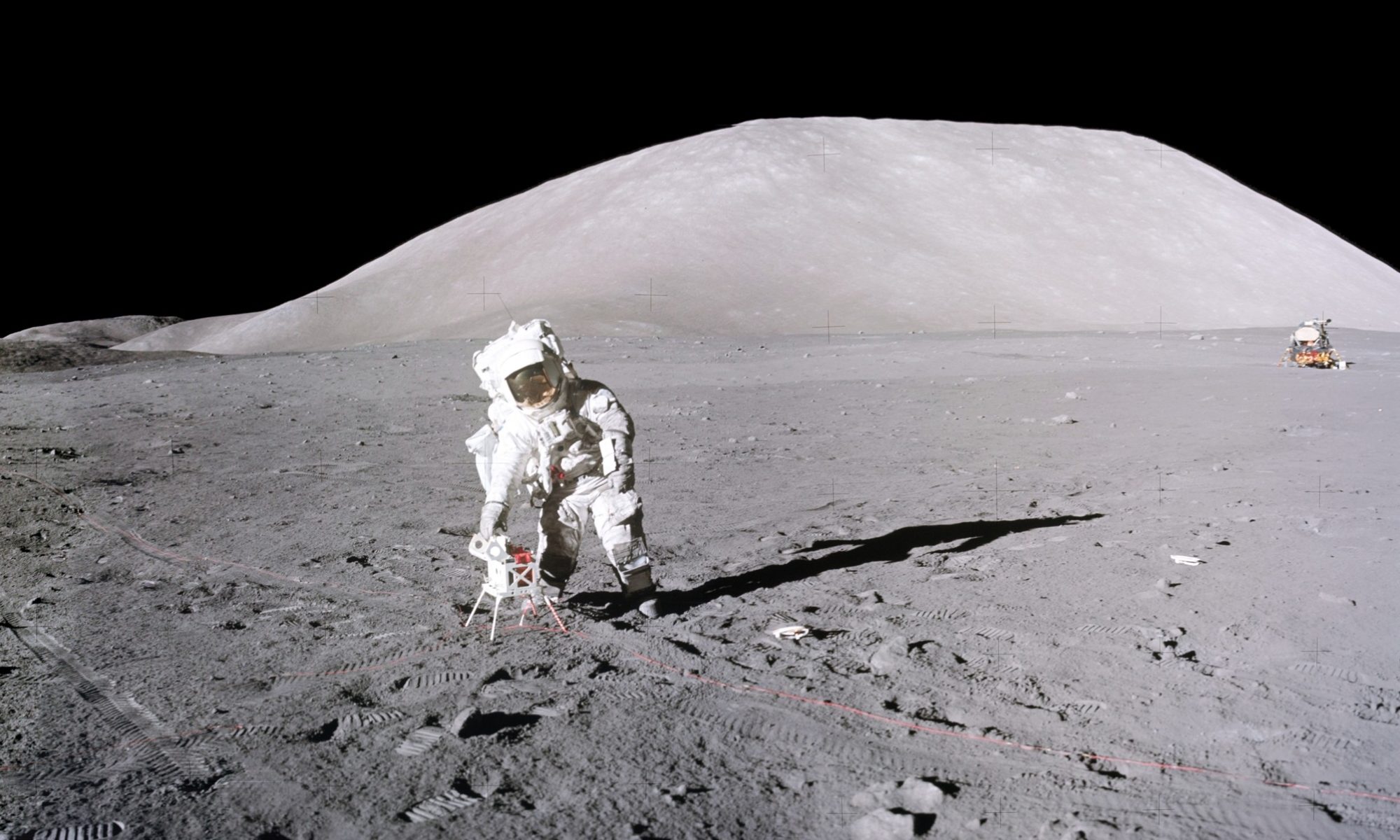 Passing through 3500 ft on its descent to the landing site in Taurus-Littrow valley, the 16 mm Data Acquisition Camera (DAC) mounted in my window of Challenger records the approach. The large crater abutting the edge of the window at left is Camelot, ~600 m in diameter. The smaller crater (of 3) immediately to its right is Holden (~240 m); and next right, Lewis (above, ~200 m) and Clark (below, ~180 m). The bright avalanche debris from the South Massif emerges from the left edge of the window, partly crossing the valley entrance. The dark oval in the branch of it nearest the reader is Shorty Crater, the site where I discovered the orange soil (Chapter 11, Section 2). In the distance, are (l. to r.): the larger (West) Family Mountain, a middle white-capped peak, and the smaller (Old) Family Mountain to its right. (see the ALSJ for a detailed discussion of this latter nomenclature).
Passing through 3500 ft on its descent to the landing site in Taurus-Littrow valley, the 16 mm Data Acquisition Camera (DAC) mounted in my window of Challenger records the approach. The large crater abutting the edge of the window at left is Camelot, ~600 m in diameter. The smaller crater (of 3) immediately to its right is Holden (~240 m); and next right, Lewis (above, ~200 m) and Clark (below, ~180 m). The bright avalanche debris from the South Massif emerges from the left edge of the window, partly crossing the valley entrance. The dark oval in the branch of it nearest the reader is Shorty Crater, the site where I discovered the orange soil (Chapter 11, Section 2). In the distance, are (l. to r.): the larger (West) Family Mountain, a middle white-capped peak, and the smaller (Old) Family Mountain to its right. (see the ALSJ for a detailed discussion of this latter nomenclature).
Author’s Note
“Contact!” recounts the events of the 6th day of the Apollo 17 mission. It includes wakeup activities; my entry into Challenger to begin the Challenger’s activation; a complete activation of Challenger’s systems; Descent Orbit Insertion-1 (DOI-1) while still docked with the CSM; preparation for undocking from America; undocking; preparation and implementation of DOI-2 by Challenger; and, of course, Powered Descent on to the lunar surface in the valley of Taurus-Littrow. Observations of both the departing CSM with Ron Evans and parts of the lunar surface from orbit are discussed and illustrated. Four videos of the undocking; fly-over of the landing site; and the landing beginning 10 miles from touchdown are included. The chapter differs from other accounts of the transcripts of this part of the mission in that I give explanations of the various LM systems and controls. I hope that the reader obtains a measure of just how complex Grumman’s Lunar Module actually was, and how well both the simulators and the flight machines performed for that era.
As before, the liberal use of endnotes, distinguishing between subjects and sources is aided by the consistent use of different font styles and colors in the text. The first endnote of Chapter 8 repeats the explanation of these color codes.
To continue reading, click “Chapter 8 – Contact!” in the sidebar at upper right under “B. Chapters 1 – 9”. That page leads directly to the beginning of the chapter. The sub-heading “a. Headings of Chapter 8” takes the reader to a Table of Contents to the headings of the chapter to facilitate later entry into the chapter.
One can, of course, also begin the whole ”Diary“ from the beginning by clicking on the header, “1. Apollo 17: Diary of the 12th Man”, in the “Pages” sidebar at the top upper right.
Copyright © by Harrison H. Schmitt, 2020, All rights reserved.
